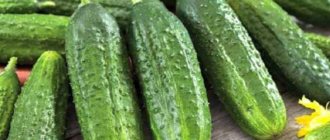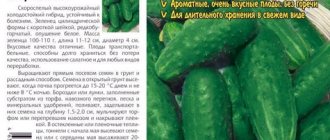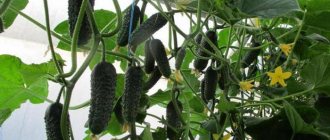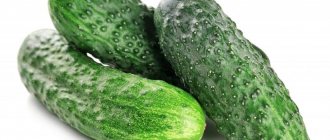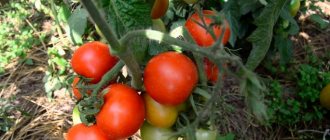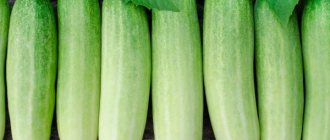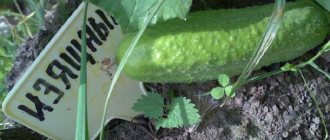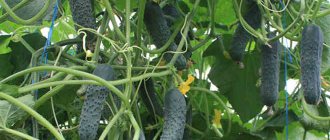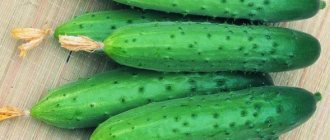Cucumber Siberian bouquet F1 is a productive hybrid, from one bush of which you get the same number of cucumbers as from a whole row of bushes of another variety. The variety is easy to care for, and the cucumbers have an excellent taste.
| Landing location | Ripening time | Mode of application | Fruit length | Group | Fruit smoothness | Pollination method |
| Universal | Early ripening (35-45 days) | Universal | Short (gherkins) - less than 10 cm | Hybrid | Highly lumpy | Parthenocarpic |
Description of the variety
“Siberian Bouquet” is an early ripening hybrid.
The growing season is from 40 to 45 days.
Fruit:
- Cylindrical shape;
- Green color;
- With dense, crispy pulp, with small seeds. There is no bitterness;
- Length - from 8 to 10 cm;
- Average weight - from 45 to 50 grams.
Bushes:
- Medium-climbing;
- They grow in height from 50 to 150 cm;
- With female type of flowering;
- With bouquet type of ovaries;
- 4-5 ovaries are formed in each leaf axil.
Reviews about the variety from those who planted
“Siberian Bouquet” is in high demand among gardeners living in harsh climatic conditions. Disease resistance and cold resistance allow for high yields.
The hybrid will be an excellent choice for summer residents with a small plot. Thanks to the presence of a bouquet type of ovaries, you can plant just a few cucumber bushes in the beds to provide all household members with green vitamins.
Super bunch cucumbers:
The cucumber variety Siberian Bouquet F1 is universal in every sense. It is suitable for growing in open ground, in a greenhouse, it blooms and sets early, is slightly susceptible to diseases, the fruits are used for salads and winter preservation.
From the name it is clear that flowering and fruiting occur in a bouquet manner. From 2 to 6 flowers and ovaries appear on one node. This variety of cucumbers quickly became popular among gardeners - a branch with so many fruits looks very attractive. In addition, the cucumbers grow crispy, juicy, and tasty.
Let's figure out how true the description of the variety and the photographs on the seed packages are.
Agricultural technology or proper cultivation
The hybrid “Siberian Bouquet” is successfully cultivated both by seedlings and without seedlings. Direct sowing of seed material is carried out after the threat of return frosts has passed. It is advisable to sow seeds in a warm bed. For this purpose, a layer of peat or rotted manure is placed on the soil. In order for the seeds to germinate faster, the soil must have a temperature of +20 to +22 degrees. The culture also needs sufficient lighting. To exclude possible cross-pollination, the “Siberian Bouquet” hybrid should be grown away from self-pollinating cucumbers.
The recommended planting pattern in unprotected soil is 60x60 cm, in greenhouse structures - 50x50 cm.
Recommendations for growing seedlings:
- The optimal period for forcing seedlings is in early April, about a month before planting in a permanent place. Seeds are sown in greenhouse structures with a heating system, bypassing the seedling stage;
- Seed material is sown to a depth of no more than 1.5-2 cm;
- The picking procedure begins after the formation of 1-2 full-fledged leaves;
- Throughout their growth, the seedlings are regularly watered, fed, provided with additional lighting, and maintained at an optimal temperature;
- Transplantation of cucumber seedlings to a permanent place begins when they reach the age of 26-30 days, after the threat of night frosts has passed, into well-warmed soil;
It is optimal to plant the crop in the middle to last days of May.
- The recommended planting density is no more than 3 cucumber seedlings per 1 m2.
Soil requirements:
- It is advisable to grow cucumbers on well-warmed light sandy loam-humus or loamy-humus soils;
- The site must be protected from cold winds;
- If there is heavy soil, sawdust or dry leaves are added to it to increase air permeability;
- Acidic soils are not suitable for growing cucumbers. To reduce excess acidity, lime, chalk and ash are added to the soil. Recommended acidity level is 6.2-6.8;
- The crop is grown in beds after potatoes, tomatoes, cauliflower, root vegetables, and legumes. Bad predecessors are zucchini, squash, and eggplant.
Growing and care
The cucumber is watered once every 3-4 days with warm water heated to the same temperature as the soil. The soil is not allowed to dry out and remain damp for a long time.
Feed three times per season:
- When the bush produces the first 2-3 leaves (apply complex liquid fertilizer for seedlings or a 1:20 manure solution).
- At the beginning of flowering (use mineral fertilizer with phosphorus, for example, superphosphate or ammophosphate).
- At the beginning of fruiting (combine mineral fertilizer with potassium, add a little nitrogen).
The soil is loosened at least once a week so that the cucumbers do not suffer from a lack of oxygen. Weeds are regularly pulled out.
Fertilizer is made from weeded weeds. They are placed in a barrel, filled with water, the infusion is allowed to ferment, and then diluted 1:7.
Care
After planting, the hybrid needs regular care to achieve maximum yield:
- Water the plantings regularly using warm, settled water. Daily watering is necessary during the period of active growth, during fruit set and during the fruiting period;
- After irrigation procedures, the soil needs to be loosened to prevent the formation of a soil crust;
- Weeds should also be destroyed;
- The crop is fed twice a month, often combining feeding with abundant watering. Mineral complex fertilizers are applied as fertilizing;
- Overgrown cucumber vines are tied to high trellises;
- The soil must be mulched with straw, rotted sawdust or peat to prevent moisture evaporation;
- The plantings are treated with fungicidal preparations - “Topaz”, “Ordan”, “Raek”, Bordeaux mixture;
- Ripe greens are collected daily.
Features of cultivation
If you do not follow the basic rules for caring for cucumbers of this variety, you can’t even dream of a rich harvest. The plant simply will not be able to “feed” all the numerous ovaries formed - most of the fruits will dry out without reaching their full size.
Let's look at the main points of growing cucumbers of the Siberian Bouquet F1 variety:
- Planting seeds for seedlings is carried out in April, or, as a last resort, in early May. If the seeds are planted in open ground, this is done in the first or second decade of May. The weather conditions of the region should also be taken into account.
Note: already on the 45th day from planting the seeds, the first greens appear. This variety bears fruit for a long time. For example, the first harvest is harvested in July, and the last in September. A real find for a gardener!
- Seedlings are planted approximately like this: two plants per 1 m². In an open garden bed, you can double the number of bushes for the same area.
- In the beds, it is advisable to make row spacing with a large amount of humus collected in the fall.
- In the middle zone and further north, cultivation in greenhouse conditions is recommended.
- Fertilizer feeding is very important; it increases productivity and improves the taste of cucumbers. The first fertilizing is necessary immediately after the appearance of the first leaf, then fertilize after the formation of the second. We count down 3 weeks and carry out the third feeding. You can choose complex fertilizers sold in any specialty store.
- Abundant watering of bushes is the key to successful cultivation and productivity. If the region is hot, cucumbers are watered twice a week. If the weather is cool, once is enough.
- A barrel with fermented infusion of herbs is placed in the greenhouse with cucumbers. This releases a large amount of carbon dioxide and increases productivity.
- Weeding and loosening are carried out as necessary. By the way, some gardeners cover the soil around cucumbers with hay after the first weeding. This way the soil stays moist and weeds grow much slower.
- Grown cucumbers are harvested every other day or even daily, depending on ripening. Overgrowths should not be allowed to form: they inhibit the formation of new ovaries and take away excess strength from the plant.
- Trellis are a must (the bushes will not be able to support the weight of the cucumbers on their own). For these purposes, poles are installed, and wire is stretched between them. A net is already attached to it, on which the lashes with cucumbers are distributed.
If all growing conditions are met, you can get the promised harvest. Long-awaited bouquets of ovaries will grow on the bushes - the same as in advertising pictures and photographs.
Reviews of cucumbers of the Siberian Bouquet F1 variety
Some note the high yields promised by advertising. For example, one gardener harvested 30 cucumbers during the first two weeks of ripening; the fruits grew in a bouquet, as in the picture.
Others, on the contrary, complain about slow growth, small yields or poor quality of cucumbers. True, it was also said that the problem was not in the seeds, but in the soil - it simply wasn’t suitable.
Daria: “I have been growing cucumbers of the Siberian Bouquet F1 variety for several years now. I even tried planting in balcony conditions. Productivity is what you need. The bushes constantly pleased us with strong and crispy cucumbers growing like a garland.”
Karina: “I bought this variety, believing the description on the bag. However, the harvest did not turn out as expected. There are only 3-4 greens on one node, and the ripe fruits are not pimply, like in the picture, but smooth, like Zozulya. These are not suitable for winter preparations.”
Ivan Arkadyevich: “I purchased the Siberian bouquet F1 by mistake. Overall, I have no regrets - the variety is no worse than others, and in some cases even better. The harvest was rich, there was enough for the whole family to eat and for canning.”
If you have chosen this variety, it is best to try it yourself and then draw conclusions.
When to sow cucumbers for seedlings?
To correctly determine the sowing time, you need to focus on the time when you will plant the seedlings in open ground. In this case, it is necessary to take into account the climatic conditions of your region. In central Russia, this procedure is usually carried out in early May.
Cucumber seedlings are transplanted into open ground approximately 15-20 days after sowing the seeds. To make it easier for you to determine the appropriate time for sowing seeds and planting seedlings, use our table, which shows the recommended timing for different regions of Russia.
| Regions | ||||||
| Southern and North Caucasian Federal District | Central and Northwestern Federal District | Volga Federal District, Belarus | Ural Federal District | Siberian Federal District | Far Eastern Federal District | |
| Sowing seeds for seedlings | 1st ten days of March | 2nd ten days of April | 1st ten days of April | 2nd ten days of April | 3rd ten days of April | 3rd ten days of April |
| Planting seedlings under film cover | 1st ten days of April | 2nd decade of May | 1st decade of May | 20th decade of May | 3rd decade of May | 1st decade of June |
Advantages of the “miracle bouquet” variety
Cucumbers “miracle bouquet” f1 are another relatively new hybrid from the Siberian Garden agricultural company.
- A unique parthenocarpic variety with high yields is intended for cultivation in open and closed ground.
- Seeds are planted at the end of April - beginning of May. After 1.5 months from the moment of planting the seeds, the first fruiting begins. With good care, one bush can form 35-45 ovaries, collected in bouquets of 4-5 pieces.
- Zelentsy have a cylindrical shape. The length of one fruit is 10-12 cm, diameter is 3-4 cm. Weight is 90-100 g. The skin of the fruit is dark green, covered with tubercles.
- Gherkins of this variety have sweet, crispy and dense flesh. They are readily used for preparing delicious salads, pickling and canning.
- The crop yield per 1 m2 of planting is 13-14 kg.
- The hybrid variety Miracle Bouquet is highly resistant to diseases and is not demanding in care and growing conditions.
Excellent for growing in regions with harsh climatic conditions - mainly for Siberia and the North.
